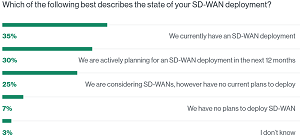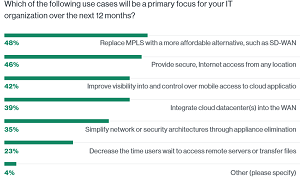News
Survey: Bright SD-WAN Outlook Driven by Cost Reduction, but Security Lags
Cato Networks published its fourth State of the WAN report, finding that the outlook for software-defined wide-area networking (SD-WAN) is bright for 2020, driven by organizations seeking to reduce WAN costs.
"Most respondents (66 percent) will have some kind of SD-WAN deployed by the end of 2020," the company said. "What's more, 40 percent of MPLS respondents will have converted to SD-WAN."
That was just one takeaway from the Tel Aviv company that touts its security-infused SD-WAN-based offering as a convergence of SD-WAN and secure access service edge (SASE).
Another highlight details why organizations are turning to SD-WAN: "Most respondents (56 percent) consider SD-WAN to reduce WAN costs. Network agility as it applies to sites -- whether in the form of faster site deployment or increasing bandwidth -- is also popular."
However, the primary takeaway from the survey, as listed in an announcement news release, is that "enterprises who deployed SD-WANs were less confident in their networks after undergoing digital transformation." Except for one certain group, that is: "Only enterprises with SASE architectures showed increased network confidence post digital transformation."
 [Click on image for larger view.] The State of WAN Deployments (source: Cato Networks).
[Click on image for larger view.] The State of WAN Deployments (source: Cato Networks).
Other findings of the survey of 1,333 IT professionals from across the globe, as highlighted by Cato, include:
- Cloud connectivity was a major factor with 69 percent of SD-WAN owners indicating less confidence post-digital transformation.
- Only 37 percent of SD-WAN respondents claimed to be able to protect locations from threats post deployment, even though most respondents (66 percent) prioritized defending against malware/ransomware.
- SD-WAN does little for security. Although most respondents (66 percent) cite defending against malware/ransomware as a primary security challenge in 2020, only 37 percent claim their SD-WANs help protect locations from malware and other threats.
- Cloud applications are key to the enterprise but not native to SD-WAN. Most respondents (60 percent) say that cloud applications will be the most critical to their organizations over the next 12 months, even more critical than applications hosted in their private datacenters. Yet SD-WAN solutions require additional software and integration to support the cloud.
- Secure mobile access, a strategic goal for IT executives, is ignored by SD-WAN. Managing mobile/remote access was the second most popular networking challenge for IT executives. More than half (52 percent) of respondents made enforcing corporate security policies on mobile users a primary security challenge for 2020. Yet, mobility is not included with SD-WAN.
- Site connectivity continues be the major driver of networking challenges in 2020. The three leading primary networking challenges for 2020 all related to site connectivity -- bandwidth costs (46 percent), performance between locations (46 percent), and managing the network (44 percent).
- Advanced threat protection, mobile security, and operational efficiencies are the major security challenges in 2020. More specifically, respondents most often cited: “Defending against emerging threats like malware/ransomware” (66 percent), “Enforcing corporate security policies on mobile users,” (52 percent) and “The cost of buying and managing security appliance and software” (51 percent).
 [Click on image for larger view.] Primary IT Focus (source: Cato Networks).
[Click on image for larger view.] Primary IT Focus (source: Cato Networks).
The survey's executive summary concluded with one more plug for SASE: "Failure to factor advanced security into any SD-WAN forces the deployment of additional solutions, which can impede visibility and complicate the deployment experience. While 64 percent of SASE users reported being able to protect locations and site-to-site connections from threats post deployment, only 37 percent of SD-WAN respondents made that claim. In short, making a tactical decision to only address MPLS limitations, ultimately leads to long-term dissatisfaction in one's network."
The survey can be downloaded -- upon providing registration details -- by going here.
About the Author
David Ramel is an editor and writer at Converge 360.